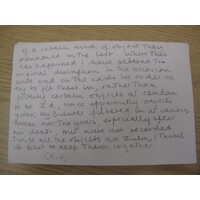Metadata
MAA catalogue card E 1914.90.49 (04)
[ Source of title : Rachel Hand for MAA ]
Textual record
E 1914.90.49
Creative Commons License: CC BY-NC-ND https://creativecommons.org/licenses/by-nc-nd/3.0/
Additional title information [Source - Nessa Leibhammer for FHYA, 2012, using MAA materials: General Card for 1914.90.1 - 154: NB The Bulwer Collection of 1912 was found to be slightly confused when it was sorted out. The objects found marked "Bulwer Collection 1912" did not always tally with the description in the Annual Report. Some objects did not appear on the list at all - these have been added to the Z Register (created by the Museum's second curator, Louis Clarke, instigated in January 1923) and as far as possible their numbers appear overleaf. All cards marked Bulwer Collection were taken out and were given the new appropriate numbers, but it was found that often there were many more of a certain kind of object than mentioned in the list. Where this has happened I have altered the original description in the accession book and on the cards in order to try to fit these in, rather than picking certain objects at random to be added to the Z Register, since apparently objects given by Bulwer filtered in at various times over the years, especially after his death, but were not recorded. Since all the objects were Zulu, I think its best to keep them together. (Note found in accession register, written by Kay Holman) - MAA (01/12/1998)]
[Source - Rachel Hand for MAA, 2016: The Museum's catalogue cards and labels are part of the institution's and the objects' very history. Catalogue cards were created to add additional object information from the very first accessions back in 1884 and replacement cards were made if the original was lost, usually using both different pens and terms. Original sale or collector labels could be stuck to the cards to add biographical layers of information in the same way that letters and later photographs were sometimes attached to cards. Staff and sometimes visitors would add comments on provenances, measurements and locations over time. Reconnecting an author with their annotations can add to our knowledge of the object's history and associations. The era and author of the cards also is reflected in their physical aspects: initially details were handwritten in ink, the 1930s saw cards stamped and written on a typewriter, followed variously by handwritten details in ballpoint pen, finally moving to word-processed and laser printed texts. Like the cards the physical type of paper and pen used can suggest dates as well as authors. They can be used to confirm the identity of misplaced objects, e.g. Henry Bulwer's collection bears distinctive long, rectangular shaped paper labels and his cursive script. Early labels were handwritten in ink, on small rectangular paper or parchment label and tied through small metal reinforced holes. Others were glued directly to the object. Smaller rectangular or square paper labels, with a printed outline, usually stuck directly to the object, usually originate in late nineteenth or early twentieth century salerooms or via a collector. Larger circular, metal-edged labels were written in the museum, probably from the 1970s onwards. The 1980s bought larger labels on thick yellow paper, and remained handwritten. From c.2000, we have used acid-free yellowish paper labels, that are written on in light-sensitive and waterproof ink.]
| Event Actor | Event Type | Event Date | Event Description |
|---|---|---|---|
| Five Hundred Year Archive (FHYA) | Online curation | 2016 - | Digital image by Nessa Leibhammer |
| Museum of Archaeology and Anthropology, University of Cambridge (MAA) | Making | YYYY |
If you have difficulty accessing the objects, use these links.

Contributions